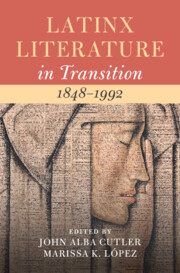Book contents
- Latinx Literature in Transition, 1848–1992
- Latinx literature in transition
- Latinx Literature in Transition, 1848–1992
- Copyright page
- Dedication
- Contents
- Figures
- Contributors
- Acknowledgments
- Introduction
- Part I Space
- Chapter 1 José Garcia Villa’s Sojourn in New Mexico
- Chapter 2 Latinx Internationalism, French Orientalism, and a Nuyorican Morocco
- Chapter 3 Centro America in San Francisco
- Chapter 4 Bridges, Backs, and Barrios
- Part II Being
- Part III Time
- Part IV Form
- Part V Labor
- Bibliography
- Index
- References
Chapter 1 - José Garcia Villa’s Sojourn in New Mexico
Rethinking the Geographies of Latinidad
from Part I - Space
Published online by Cambridge University Press: 10 April 2025
- Latinx Literature in Transition, 1848–1992
- Latinx literature in transition
- Latinx Literature in Transition, 1848–1992
- Copyright page
- Dedication
- Contents
- Figures
- Contributors
- Acknowledgments
- Introduction
- Part I Space
- Chapter 1 José Garcia Villa’s Sojourn in New Mexico
- Chapter 2 Latinx Internationalism, French Orientalism, and a Nuyorican Morocco
- Chapter 3 Centro America in San Francisco
- Chapter 4 Bridges, Backs, and Barrios
- Part II Being
- Part III Time
- Part IV Form
- Part V Labor
- Bibliography
- Index
- References
Summary
Before the categories of Latino/a or Hispanic were adopted in academia and literary criticism in the United States, Latinx writers were often (mis)placed within a wide and ambiguous “Spanish” literary scene. This chapter explores how this tendency also extended to Filipinx American writers. It centers on José Garcia Villa’s early years in the United States, in particular the semi-autobiographical short stories in Footnote to Youth: Tales of the Philippines and Others (1933), wherein he reflects on his experience as a young Filipino American writer and finds continuities between the Philippines and New Mexico.
- Type
- Chapter
- Information
- Latinx Literature in Transition, 1848–1992 , pp. 19 - 36Publisher: Cambridge University PressPrint publication year: 2025

